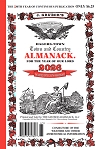Imitators of The Hagerstown Almanack Part 3
BUY THE GENUINE ACCEPT NO OTHER
Caroline Robertson obviously had the virtue of persistence. She continued to publish T. G. Robertson’s Hagerstown Almanac, but beginning with the 1880 issue, she gave it an entirely new front and back cover. These changes were sufficient to distinguish the two almanacs, despite the fact that T. G. Robertson’s was nearly hidden on the shield at the top of the cover, which made the title appear to be simply Hagerstown Almanac.
With the 1891 edition, the large Baltimore printing firm of Fleet, McGinley & Co., acquired the Robertson almanac and revived its claim to be the legitimate successor of the almanac that John Gruber had begun nearly a century earlier. The new publisher reprinted Caroline Robertson’s 1874 "Hagerstown Almanack in a Nut Shell” and including in the heading "Why We Claim To Be the Original.” And in 1893, Robertson’s reprinted an anonymous newspaper poem "His Old ‘Hagerstown’ Almanac,” even though it was clearly about Gruber’s Hagerstown Almanack, not Robertson’s. It included the line "I’m used to it, I've seen it round from boyhood to old age.” Once again, Robertson’s Almanac was implying that it was the legitimate continuation of Gruber’s.
In 1894 Robertson’s Almanac became identical, except for the cover and title page, with Otho Swingley’s later series of Hagerstown almanacs, and with the 1896 edition, Fleet, McGinley transferred ownership to Swingley’s National Union Almanac Co., Baltimore, which remained its publisher for the remainder of its existence.
1886 was a key year in the long history of Gruber’s Almanack. Its publisher, Milton A. Berry, died on 12 January, and two other publishers got into the act by issuing new imitations of Gruber’s. Swingley’s second attempt to publish his own "Hagerstown Almanac” began with the edition for 1887, and Wooldridge’s Hagerstown Almanack apparently began at the same time.
Robert A. Wooldridge & Co. of Baltimore, an importer of guano (a fertilizer made from bird dung and imported from islands off the coast of South America), published its own "Hagerstown Almanac” from around 1887 to 1912 or later. It had three different titles: Farmers’ and Planters’ Hagerstown Almanack ([1887?]–1896), Wooldridge’s Hagerstown Almanack (1897), and Farmers’ and Merchants’ Hagerstown Almanack (1898–ca. 1912). The title page and inside front cover of early Wooldridge’s almanacs imitate Gruber’s. Wooldridge was certainly capitalizing on the fame of the Gruber almanac, but since Wooldridge’s was distributed free as an advertising vehicle, it did not directly compete with Gruber’s.
Otho Swingley was the most persistent imitator of J. Gruber’s Hagers-Town Town and Country Almanack. His own published comments are an amalgamation of self-righteousness, hyperbole, and outrage, an emotion he was able to achieve at a moment’s notice.
After he had published his short-lived New Hagerstown Almanack in the 1860s, Swingley moved to Baltimore, and became junior partner with M. A. Berry in the publication of J. Gruber’s Hagers-Town Town and Country Almanack, beginning with the 1875 issue. This arrangement continued through the Gruber almanac for 1884, when the partnership broke apart and Berry continued publication of the almanac without Swingley.


















